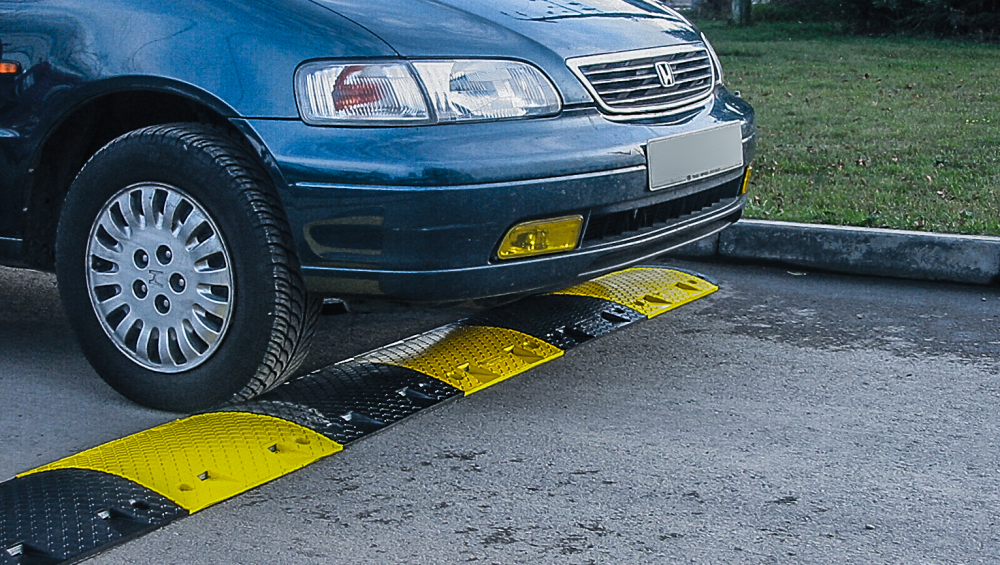Ultimate guide to speed bumps

Looking to purchase speed bumps? Or simply want to brush up on your knowledge on why we have speed bumps? From speed bump regulations in the UK and applying for speed bumps on your street, to who invented speed bumps, our detailed guide covers it all.
What is a speed bump?
Speed bumps are a traffic calming measure used to slow down the speed of vehicles. These are often used in residential or busy pedestrian areas, such as around schools. They can also be for worksites, or wherever traffic calming measures are required.
Speed bumps FAQs
Why do we have speed bumps?
Speed bumps, as well as other traffic calming measures such as speed cameras and speed control signs, are designed to slow down traffic – improving safety for drivers, pedestrians, passengers and other vehicles on the road.
How tall are speed bumps?
The average height of a speed bump is around 6.5 to 7.5cm, which is recommended by the government who have regulations on speed bumps dimensions for the UK. However, in 1999, the Department for Transport set that speed bumps must be a minimum height of 2.5cm and maximum height of 10cm. This then means that drivers must slow down to a speed of around 5mph to navigate a road speed bump without damage.
How wide are speed bumps
According to speed bump regulations in the UK, all speed bumps must be at least 900mm in length, and the gradient of the speed bump must be no more than 1:10.
Who invented speed bumps?
Physicist, Arthur Holly Compton, invented ‘traffic control bumps’ in 1953, which are now known as speed bumps. He initially invented these to stop cars speeding when they drove past his university. However, traffic calming was first introduced around 1906 in New Jersey, USA – when the average speed of an automobile reached 30mph – which then led to the invention of speed bumps.
How far apart should speed bumps be placed?
It’s recommended that speed bumps should be placed between 20 metres and 150 metres apart, however, the average spacing is normally around 70 metres apart. It should be noted that the spacing between road speed bumps will influence the average speeds of the roads.
What’s the difference between speed bumps and speed humps?
The main differences between speed bumps and speed humps are what they are made from – for example, plastic/rubber, or tarmac – and their size.
Speed bumps are usually made of plastic or rubber, and are clearly marked with paint so drivers can spot them easily. They are usually as high as 10cm, and are typically used in parking lots, residential areas and private roads – as the height of the speed bump requires a significant reduction in speed.
Speed humps, on the other hand, are the large bumps which span the entire width of the road. Typically covered in tarmac, they appear to be more of a feature of the road. Although their maximum height is the same as speed bumps, typically, they’re not this tall – meaning speed reduction wouldn’t be quite as much as speed bumps.
Do speed bumps damage cars?
Road speed bumps pose the same problems for cars and tyres as potholes do – if you drive over them at a high speed, they can potentially cause damage to your vehicle. This would typically cause issues with tyres – such as misalignment or uneven tyre wearing – or issues with suspension. Speed bumps are designed to be driven over at a low speed as a traffic calming measure.
Applying for speed bumps
Often, people wonder how to get speed bumps installed on their street in the UK. Applying for speed bumps is a process which will involve:
- Organising your campaign
- Determining whether speed humps are appropriate for your street
- Communicating with your local council with your case of why your street should have speed humps
- Getting your local council to act
For more information, visit your local council’s government website.
Where can I buy speed bumps?
Looking to buy speed bumps for private roads, parking lots or worksites? Wherever traffic calming is required, Oxford Plastic’s EnduraRamp Speed Bumps are the perfect solution. Highly visible in black and yellow coloured material, the EnduraRamp is suitable for up to 44 tonne vehicles – designed to be installed on good condition concrete or asphalt.
For more information on how to buy speed bumps, get in touch with a member of expert team here at Oxford Plastics. Alternatively, browse our selection of signs, cones and speed bumps.
Related News

An Industry Guide to LowPro Road Plates and Trench Covers
Across construction and utilities in gas energy, waste-water, water suppy and fibreoptic works, keeping people safe and sites...

Protecting History: LowPro 15/05 Road Plate at St Catherine's College
We all know that renovating a listed building is never straightforward, especially when that building is a modern architectur...

The Kit List That Keeps Your Team Safe (and You Covered)
When it comes to running a safe, compliant, and efficient site, the right kit can make all the difference. From managing foot...